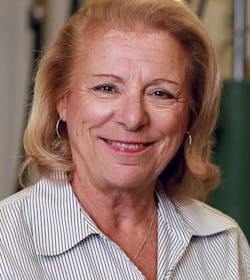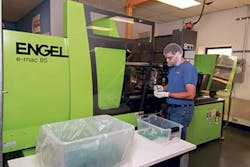In the tricky world of molding liquid silicone rubber (LSR), technical prowess is a must. Overmolding LSR to a thermoplastic is a specialty niche in which only a handful of molders can claim expertise. Marrying LSR of one durometer and color to an LSR of another durometer and color also is a specialty endeavor.
Just the facts
COMPANY: Extreme Molding LLCHEADQUARTERS: Watervliet, N.Y.OWNERS: Lynn Momrow-Zielinski and Joanne Moon DuncanFOUNDED: 2002EMPLOYEES: 64ANNUAL SALES: $5 million to $10 million
UNIQUE FACT: Extreme Molding's operations are located on the grounds of the Watervliet Arsenal, a U.S. Army-owned and operated manufacturing facility in Watervliet that is the nation's oldest continuously active military arsenal. In 1999, local leaders in government, business and education created the Arsenal Business & Technology Partnership to spur economic growth by offering incentives for private businesses to move into underutilized space.
The processing steps are quite different for each material, according to Lynn Momrow-Zielinski, a co-founder, co-owner and managing partner of Extreme Molding LLC, Watervliet, N.Y.
"However, that intellectual know-how is a core of our business," she said during a visit from Plastics Machinery Magazine.
Major markets, including the automotive, medical, food, pet and consumer sectors, are driving demand for products that combine the soft-touch, chemical-resistant and shape-retention qualities of silicone with a rigid thermoplastic substrate. This demand is spurring new product designs.
Extreme Molding specializes in making challenging high-end consumer and health-care products, and its work can be seen throughout both industries. It uses proprietary mold designs and machinery settings to manufacture pacifiers, teething toys and toothbrushes for infants and toddlers, health-care products for women, and high-end consumer products.
Extreme Molding operates 14 horizontal injection presses with clamping forces ranging from 45 tons to 110 tons. Its manufacturing and administrative operations occupy about 13,000 square feet of space.
Extreme Molding's hard-to-make multimaterial products include a teething brush for infants called Baby Banana Brush, designed by Live-Right LLC, Pocatello, Idaho, to maximize comfort and safety.
The product is made from two LSR materials with different colors and durometers for the handle and the bristles. The product initially was made by a molder in Taiwan, but Extreme Molding won the business.
The custom molder also does a fair amount of business producing single-material parts. In addition to silicone, the company processes a range of high-performance and engineering materials, including Tritan copolyester from Eastman Chemical Co., PC, liquid crystal polymer, PEEK, TPE, polyetherimide, fluoroelastomers, fluorosilicones and food-grade and Class 6-compliant silicones.
PURCHASING PRESSES & SOURCING MOLDS
Over the past year, Extreme Molding has purchased and installed two new all-electric Engel e-mac machines with 85 tons and 110 tons of clamping force.
The e-mac series is very precise, has a small footprint and easily accommodates a robot interface, all very important characteristics for Extreme Molding, said Joanne Moon Duncan, the company's other co-owner, co-founder and managing partner.
The company's machine operators also like the CC300 control, which has a large touch-screen and icon-based graphical interface that permits easy navigation. Its e-move central control feature allows for instant, safe and variable control of each machine and robot movement.
Extreme Molding also has an Arburg press, an EcoPower 110 from Wittmann Battenfeld and a Toshiba EC65. It recently purchased a Toshiba all-electric press with 110 tons of clamping force.Momrow-Zielinski and Moon Duncan work together to make all decisions regarding capital equipment purchases, and bring more than 50 years of experience in materials development to their business.
Each machine is dedicated to molding one material, processing either LSR or a thermoplastic, Momrow-Zielinski said. To create the overmolded part, a machine operator stationed between two presses manually transfers the intermediate part from one machine to the next.
The company typically makes parts that weigh less than a pound, using molds with up to 16 cavities. The company said it sources simpler, low-cavitation molds that process silicone or thermoplastic from small local mold makers.
More complex, high-cavitation tooling is procured through an LSR mold-making specialist such as M.R. Mold & Engineering Corp. or Kipe Molds Inc., Momrow-Zielinski said.
"LSR molds must do away with ejectors or retractable mold cores because these components can cause issues that can render the part useless," Moon Duncan said. Numerous components common in a traditional mold must be redesigned or eliminated when molding with LSR because it can produce flash with a mold gap as small as 0.0002 inch.
The type of molding projects that Extreme Molding tackles push silicone molding beyond its traditional applications such as gaskets or O-rings, production manager Mike Fil said. The parts that Extreme Molding makes are complex, with thick and thin sections and curved surfaces. LSR also can be an alternative to TPE in applications where chemical resistance is important.
"Silicone is inert, and can be sterilized, too," Fil said.
Extreme Molding's expertise and manufacturing savvy have yielded consistently high-quality parts; since the company's inception, fewer than 1 percent of clients have registered a complaint or returned a product, Momrow-Zielinski said. Extreme Molding's knowledge in both LSR and thermoplastics allows it to think outside of the box as it helps customers design and manufacture high-quality parts.
AUXILIARIES AT WORK, SECONDARY OPERATIONS
Choosing the right dosing unit is critical to LSR molding; each of Extreme Molding's dosing units comes from Graco Fluid Automation, North Canton, Ohio.
The company is very selective in how it incorporates automation into its processes. This helps to keep overall project costs down but increases the importance of each employee's attention to detail regarding the process. Officials can incorporate an item they refer to as a robotic part sweeper into the mold. This was designed by Extreme Molding and mold maker M.R. Mold. The sweeper automatically demolds an LSR part without operator involvement. It is an alternative to part demolding with an ejector pin, and is designed to eliminate any chance of damage to the surface of the cured part.
One example of automation is in the fulfillment, packaging, and shipping area, where a blister packaging machine from Sonoco Alloyd automatically packages products such as the Baby Banana Brushes.
In 2016, Extreme Molding moved its full inspection, assembly, packaging and fulfillment operations away from its manufacturing space and into a separate building on the military campus that it calls home. About 8,000 square feet in the building is used by Extreme Molding for finishing, shipping and temporary product storage. The facility, which also houses non-plastics tenants, is a Class 100,000 clean environment. In this area, employees wear hair and beard nets to avoid contaminating products.
Extreme Molding recently added dry-ice cleaning from Cold Jet LLC to speed cleaning times for molds and machinery components, such as screws. Fil said the dry-ice device eliminates the need to use chemicals or non-flammable mold cleaners and shortens cleaning times to about 10 minutes.
Mikell Knights, senior staff reporter
Contact:
Extreme Molding LLCWatervliet, N.Y., 518-326-9319, www.extrememolding.com





